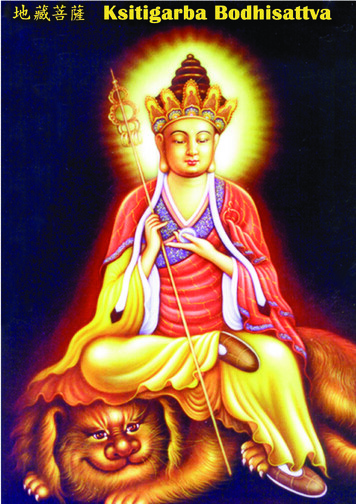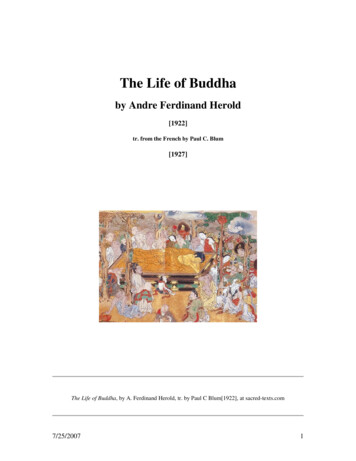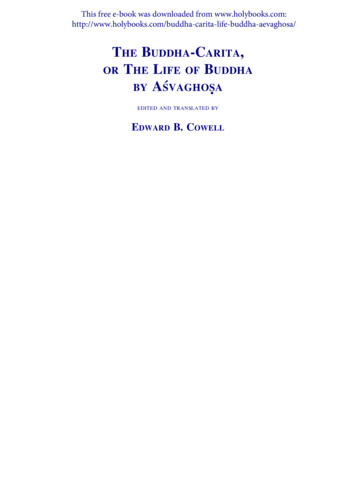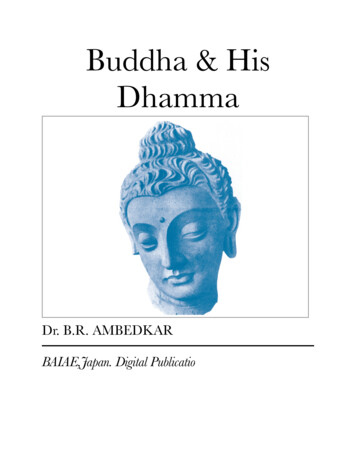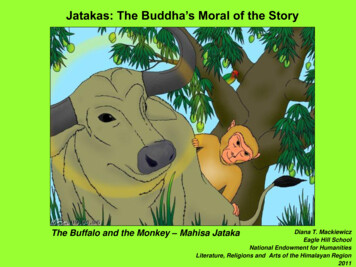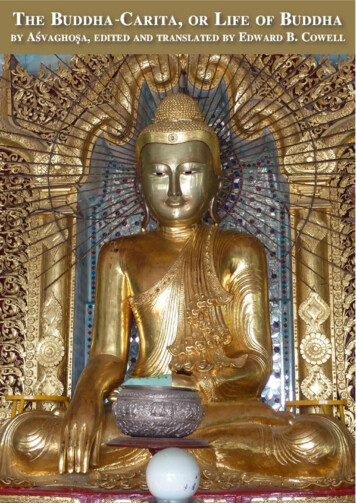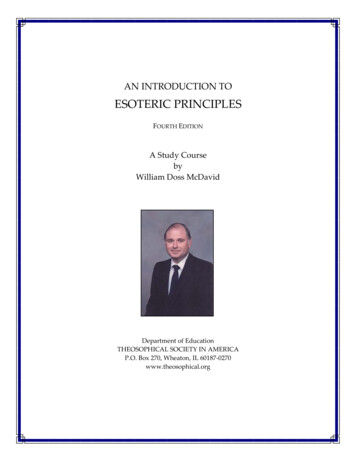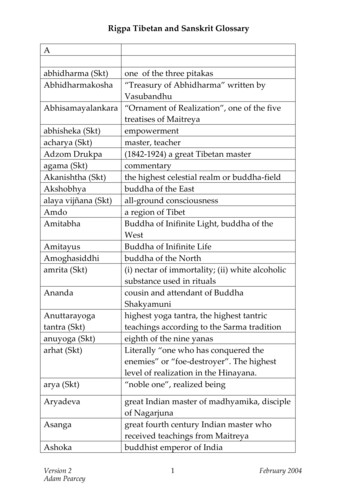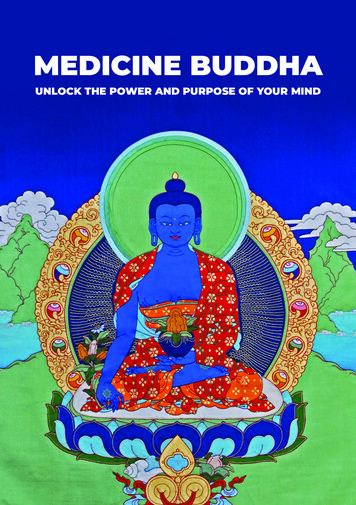
Transcription
MEDICINE BUDDHAUNLOCK THE POWER AND PURPOSE OF YOUR MIND
DEDICATIONWith heartfelt gratitude to my precious gurus:Les Sheehy, extraordinary source of inspiration and wisdom;Geshe Acharya Thubten Loden, peerless master and embodiment of theDharma;Zasep Tulku Rinpoche, precious Vajra Acharya and yogi.Guru is Buddha, Guru is Dharma, Guru is Sangha,Guru is the source of all happiness.To all gurus I prostrate, make offerings and go for refuge.May this book carry waves of inspiration from my own gurusTo the hearts and minds of countless living beings.May all beings have happiness and the true causes of happiness.May all beings be free from suffering and the true causes of suffering;May all beings never be parted from the happiness that is withoutsuffering, the great joy of nirvana liberation;May all beings abide in peace and equanimity, their minds free fromattachment and aversion, and free from indifference. David Michie 2020Cover image: Medicine Buddha courtesy of Norbulingka Institute, where youcan purchase thangkas, statues and malas: www.norbulingka.org
MEDICINE BUDDHAUNLOCK THE POWER AND PURPOSE OF YOUR MINDDavid MichieCONTENTSIntroductionHow do Tibetan Buddhist healing practices work?513A Western perspectiveWhere does Medicine Buddha fit within27Tibetan Buddhism?The practice of Medicine Buddha43Conclusion51
4
INTRODUCTIONThe words ‘medication’ and ‘meditation’ are only one letter different forgood reason: they both come from the Latin root, medeor, meaning ‘toheal,’ or ‘to make whole.’ Whether we medicate or meditate, our purpose isthe same.While advances in Western medicine have been extraordinary, theirfocus has been primarily been on humans as biological systems. Lesswell known, but no less extraordinary, the healing practices of TibetanBuddhism have had a similar but opposite focus on humans as energeticsystems.It is our immense good fortune to be living at a time when we haveaccess to the best of both East and West.Body and mind: two aspects of the same wholeThe interplay between energy and matter, or mind and body, isincreasingly accepted. No medical eyebrows would be raised by thesuggestion that stress is a cause of cardiac arrest or that anxiety can lead5
to digestive problems. Dis-ease of the mind manifests in physical form.The only question is: how much?The onset of disease may therefore present us with an intriguinginvitation. What if illness isn’t simply accidental, but rather has come aboutbecause something in our inner state is out of kilter? Many of us may beexposed to a virus but only some of us will be affected by it and to verydifferent extents. Why so?In the West, when we become sick our first instinct is often for medicine- an external, physical fix. Even when our symptoms are of the mentalvariety, such as depression or insomnia, we are just as likely to emergefrom our doctor’s rooms with a prescription for a drug, as we would witha referral to a psychologist. We may believe we’re on the road to betterhealth, clutching that prescription. And who knows, perhaps that belief willdo as much for us as the drugs themselves? But unless we use the powerof our own minds, it’s like going into battle against disease with one armtied firmly behind our back. Why would we choose to do that when we alsohave such powerful inner tools at our disposal?6
Illness as a pathway to inner growthIn my early thirties, for the first time in my life I started breaking out insmall, angry welts which, as the weeks progressed, developed into fullblown rashes that might appear on my leg, arm or torso. After an especiallybad case when my whole back was a welt of hives, I went to the doctorwho correctly diagnosed an allergy of unknown origin and prescribed antihistamine pills. If you start feeling itchy, he told me, just take a pill and itwill clear up.It did. But several months later, popping yet another pill, I recognized Iwas merely masking the symptoms and doing nothing about the cause. Istill had no idea what the cause actually was. The fortuitous arrival of aleaflet from a local naturopath saw me sitting in her office one afternoon.Unlike the doctor, she had the time to ask about everything I typicallyconsumed on a daily basis. Once we reached my fifth cup of coffee of theday, she gently suggested that I may have a caffeine intolerance. She alsoobserved that I was highly stressed. Her prescription was a rigorous detox– and meditation.7
It is no exaggeration to say that her suggestion has transformed mylife. Decades later I am actually grateful to have gone through that timeof caffeine intolerance. It turned out to be the path by which I came toexperience a much more relaxed, panoramic, outwardly-focused andbenevolent reality than the intense and tightly-grasped version I inhabitedbefore. My physical disease turned out to be the catalyst for inner growth.I know it’s the same for many others. I’ve been told by people howgrateful they feel even for having had life-threatening conditions likecancer or heart attacks. We can reframe physical illness as a motivator toreassess who and what really matters to us, or to make changes we mayhave already have sensed should be made. Vicktor Frankl, the psychiatristand Holocaust survivor, who experienced, first hand, what it means to loseeverything made the observation: ‘Everything can be taken from a man butone thing: the last of the human freedoms—to choose one’s attitude in anygiven set of circumstances, to choose one’s own way.’Illness may leave us diminished and frightened. Or more empathetic,compassionate and authentic. Physical suffering may be used to propel uson a journey of transcendence. As it is understood in the East - no mud, nolotus.8
Mind training for healing and transcendenceHow, exactly, do we transform mud into lotus? What, precisely, arethe methods by which we use mind, as well as conventional medicine,to help prevent and counter disease? Tibetan Buddhism provides anumber of healing practices, with perhaps the best known being MedicineBuddha - a powerful, holistic package of meditation, mantra recitation andvisualization.Before going further I should emphasize that Buddhism is a non-theistictradition. There is no belief in an external, benevolent, omnipotent beingwho, asked the right way, will free us of disease. The Buddhist view isthat if such a being existed, it would already have acted. Which one of us,despite our limitations, wouldn’t end disease forever, given the chance?It’s more helpful to think of Medicine Buddha as embodying qualitiessymbolic of potent energies to which we can gain access by followingthe same practices used by others for millennia. An understanding of theBuddhist concept of sunyata supports an accurate understanding of thisnotion.9
Our main challenge as we approach the practice is our tendency tosell ourselves short. In a society which still unknowingly clings to theoutmoded ideas of Newtonian physics, we believe that matter is all thatexists, and as a result have a tragically diminished idea of who and what wereally are.Tibetan Buddhist masters of consciousness, like quantum scientists,have a different perspective. What if solid matter really is more illusion-likethan real? If the way that things exist has a fluidity and interconnectednessand depends as much on the mind of the observer as on what is beingobserved? What if our consciousness isn’t, in fact, the size of our heads,but has no boundaries at all? If particle is also wave, and the way itmanifests can be influenced by intention? Such possibilities open up anentirely complementary pathway to healing.The founder of the Tibetan Buddhist Society which I attend, GesheAcharya Thubten Loden often used to lean forward on his teaching throne,with the index finger of his left hand curled tightly.‘Your problem is that your mind is like this,’ he used to say. ‘The size of asesame seed!’10
Geshe-la was constantly inviting us to think bigger, to expand our view ofconsciousness and what was possible – practices he exemplified himself.It is my privilege to extend his invitation onto you. Your mind is not thesize of a sesame seed. You consciousness is capable of far more thanyou may think. When it comes to healing, you don’t have to swallow thecapsule or receive the chemo and just hope for the best. There are alsoother things you can do besides. Through the Medicine Buddha we havethe extraordinary opportunity to unlock the power of our own minds – andto emerge from whatever challenges we face with more gratitude, lightnessand an expanded sense of possibilities than anything we may currentlyimagine.11
12
HOW DO TIBETAN BUDDHIST HEALINGPRACTICES WORK?A WESTERN PERSPECTIVEWhen Tibetan Buddhist lamas teach healing practices like MedicineBuddha, they don’t usually talk in terms of evidence-based research,however compelling that research may be. The profound impact ofmeditation on endorphins and telomeres may be exciting to those of uswho seek proof that these exotic, Eastern practices really work. In theHimalayas, however, where Medicine Buddha has been practiced forcenturies and Tibetan Buddhists have a natural reverence for their teachers,they are happy to take such practices on trust.We may smile indulgently, at this idea. But how different is it from thesame trust we invest in our pharmacists or doctors? If they tell us thatsome kind of medicine will help us, chances are we’ll believe them. Wehave no way to question whatever technical explanation they may offer.We take the medicine because we trust that they are more educated in thesubject than we are, and that their motivation is benevolent.While long accepted in the Himalayas, mind-based healing practices13
are, nevertheless, still relatively new in the West. So for those of us whoare naturally inclined to empirical rigor, it is reassuring that when studiedthrough the lens of scientific inquiry, abundant evidence has been foundto show that they work. Interestingly, it is only in recent years we havehad technology sufficiently sophisticated enough to measure just howprofound some of their impacts are, because they mostly occur beneathour conscious awareness.In this section I explore a number of different ways we can accountfor the effect of mind-based healing. Some of these are stronglymeasurement-based. Others are more hypothetical. Feel free to take onboard those you find useful and put to one side those you don’t.Meditation is intrinsically healingMeditation is a healing activity. The simple act of sitting in meditationposture while focusing the mind has a profound impact on mind and body.Back in the 1980s Harvard Medical School cardiologist, Dr. Herbert Benson,began investigating how to help his patients’ bodies do what they do best:repair themselves. Exploring a variety of different methods, meditation was14
the one that best optimized self-repair. He found it particularly striking thatself-repair was boosted well beyond any specific meditation session, andthat over a period of time its benefits were cumulative.A huge volume of research shows that when we meditate, wehormonally shift gear, producing significantly less cortisol, a stresshormone, and dramatically increasing endorphins, which boost ourimmunity. Endorphins are our front-line defense against viruses and otherforeign organisms. It’s no accident that we’re more likely to fall victim tocold and flu viruses when we’re feeling run-down.In this current time of coronavirus, being anxious and worried isn’tsimply an unhappy place to be mentally. It almost certainly means that ourendorphin production is way below where we’d want it to be. Even if we areunable to fend off a highly contagious virus, the severity with which we areaffected will be determined in part by our own immune defenses. Takingcontrol of our mental state is therefore of vital importance.Another immunity-boosting hormone, which markedly increases whenwe meditate, is melatonin, a powerful antioxidant that destroys harmful freeradicals, which cause huge destruction at a cellular level.15
Seratonin, a neurotransmitter turbo-charged by meditation, helpsregulate mood, appetite and sleep. While it may not directly impact onour immune response, it plays an important support role. Intriguingly,most anti-depressants prescribed today are Selective Seratonin ReuptakeInhibitors or SSRIs which work by increasing levels of serotonin in the brain.How about we give ourselves a daily anti-depressant by meditating?Recent studies show how meditation can help manage chronicinflammatory conditions such as rheumatoid arthritis, asthma andinflammatory bowel disease. It can slow the rate of ageing by elevatinglevels of telomerase – the enzyme supporting the resilience of thetelomeres that cap our DNA.Evidently, meditation changes our body chemistry measurably andsignificantly for the better. But how? In simple terms, our bodies arehighly effective at physiologically translating whatever is going on in ourmind. Horrified thoughts cause the prefrontal cortex of our brain to shutdown, our amygdala to ramp up, and we are instantly primed for fight orflight. Sexual thoughts cause an altogether different chain of hormonal andphysiological reactions. As we think, so we become - sometimes, almostinstantly.16
When we meditate, we are deliberately optimizing our state ofmind - and our body responds. Calm, confident and serene translatesphysiologically in ways we are only now able to measure. What is known forsure is that regular meditation supports the most happy, healthy, immune,well-adjusted and pain-free version of ourselves. And its side-effects areentirely positive!What we imagine has the same biological impact as what is realIn a now-famous experiment by neuroscientist Alvaro Pascual-Leone,people with no piano-playing experience were recruited and taught to playa simple melody of just a few notes. The subjects were divided into twogroups with one group allowed to practice on a piano, and the other allowedto sit at the piano but only imagine playing the melody.Using Transcranial Magnetic Stimulation, Pascual-Leone mappedeveryone’s brain activity before, during and after the experiment. Whathe found was that people who only imagined playing the melody showedexactly the same brain changes as those who actually did. Their brainsresponded to the imagined as though it was real.17
In a different study by Professor Karen Olness, children were shown avideo in which policemen puppets – personifying the immune system –battled against virus puppets, with a simple explanation of what was goingon. The video was followed by a guided visualization during which thekids were asked to imagine lots of policemen puppets throughout theirbodies. When saliva samples were taken, their immunoglobulin levels weresubstantially higher, as though they had been fighting off a real infection.For minds and bodies, what we imagine can be real. We experiencepure terror, with all its physiological impacts, walking along a country pathand stepping on what we think is a snake, even though it turns out to be abranch. We may be aroused by the imagined presence of our lover, eventhough he or she is in the next city. Our minds are suggestible.The focal point of all healing practices in Tibetan Buddhism is apowerful visualization. In the case of Medicine Buddha, for example,healing lights and nectars stream from the Buddha’s body and bowl intoone’s own body, eliminating all negativities, disease, and harmful viruses,as well as immeasurably strengthening one’s own immunity, energy levelsand resilience. We are always encouraged to make this process not onlyas vivid as we can, but also personal. If, for example, we are battling with18
cancer in a particular organ, then a visualization focusing on that particularorgan is recommended.We experience what we expectAlthough we believe ourselves to be impartial observers of the worldaround us, the neuroscientific reality is that we are much more the creatorsof our own reality than we suppose. Our experiences are shaped to a largeextent by expectations and beliefs – a dynamic responsible for a significantlevel of healing.The placebo effect is what happens when a person is given a sugarpill with no therapeutic agent and told it will relieve their pain - and a shortwhile later the pain has gone. Repeated tests show placebos to be aseffective as real drugs in anywhere between 15% - 70% of all healing.Placebos have been studied as treatment for a wide range of conditions,from chronic pain and depression, to Parkinson’s disease. Studies haveshown that placebos are effective irrespective of factors like intelligence,or even because people really want them to work. And their result is notpurely subjective – studies of asthma patients showed less constriction19
of the bronchial tubes, and patients suffering from chronic pain had higherconcentrations of endorphins after taking a placebo. Significantly, the morecontact with a physician or doctor, the greater the placebo effect.In our Western culture, faith healing has had an established placeamong some religious groups, where spontaneous remission and othermiracles continually occur. These are attributed to God, angels, the HolySpirit or other powerful and external agencies.Growing up in Zimbabwe, I was familiar with the powers of the N’anga,or traditional healer, in Shona society, who was believed to possess notonly curative abilities, but also the sinister power to put the curse of deathon people – who might unaccountably waste away or develop a terminaldisease.The common theme running through all these is that belief, trust orexpectation, in itself, can be enough to create healing. Whether we placeour confidence in the doctor in the white coat, the priest in the purple robesor the N’anga in his leopard-skin, or the agencies they invoke – science,God, spirits – the process is the same.One thing I like about Tibetan Buddhism is the way it cuts through all20
this to what is really going on. Yes there is an important role for a leader - inour case a teacher - to communicate confidence in the process. Ritual, too,has it’s place. But healing isn’t arising from a force outside us, even thoughit may be helpful to objectify the process in such a way. The power residesin our own mind. So let’s place our confidence in that, and in the specificpractices evolved to tap into some of our own under-utilized capacity toheal.ResonanceActions undertaken in the past become easier and more effective forliving beings to carry out in the future. For example, if rats are taught a newtrick in a laboratory in USA, rats in laboratories in other parts of the worldwill learn that same new trick more quickly (Rupert Sheldrake, MorphicResonance). Over time, people score higher and higher on standard IQtests – a phenomenon known as the ‘Flynn Effect’. Average scores of 100rise steadily over a period of years. There is no indication that people arebecoming more intelligent, merely that they are getting better at doingintelligence tests. When the tests are revised, as they are periodically,scores once again return to 100.21
The theory of resonance – and it is still a theory - suggests that whenwe do something that has been done before, we become linked, throughan organizing pattern of influence, or a field, to others who have done thesame thing. We resonate with them. Like other fields—electric, magnetic,radiation—the field may be invisible, but its effects are not.What happens when we recite a mantra that has been repeated bymillions of people for thousands of years? When we focus on the sameimage that they have focused on and conduct the same process ofenergetic invocation? We bring ourselves into resonance with them. Webenefit from their cumulative influence – and in turn, contribute to thatinfluence for the benefit of those who follow.As we sit in our room reciting mantras, we may be physically alone,but in a different way we are tuning into an influence and community, anenergetic field reaching through time and space in ways beyond what wegenerally consider.22
The energetic power of mantrasFrom the earliest of times, sound has been regarded as a subtlemanifestation of energy. Pythagoras taught that just as one plucked stringcan cause another to vibrate, our own mind resonates when exposed tocertain sounds. We all know how certain pieces of music make us feelhappy or moved, and studies show that sound can change our physiologicalfunctioning too.Tibetan Buddhist healing mantras are usually in Sanskrit, the 4000 yearold Indo-European “mother language,” and origin of a surprising number ofour own words in English. The word “mind,” appropriately, comes from theSanskrit “man.” And mantra, short for man-traya, translates literally as mindprotection.Sanskrit arose initially as an oral, rather than written, language, withthe emphasis on sound. Ancient meditation practitioners from the timeof the Vedas understood that we comprise not only physical systems, butenergetic systems too – the channels and chakras of a subtle body. It isbelieved that mantras embody specific sounds and rhythms to impact onour subtle energy or prana, which in turn has a physical manifestation. The23
way that we move our mouth and tongue to form mantras, as well as thesound of mantra itself, has a subtle, energetic impact, whether we chantmantras aloud or whisper them under our breath.Mantras can be used for a variety of purposes besides healing – toinvoke energy, confidence, harmony and equanimity to name just a few.And they are always repeated a number of times – 21 and 100 beingcommon mantra counts, with wrist malas – or rosaries – and standard sizemalas designed for this purpose.Repetition of any action has been shown to change brain functioning.In the words of Canadian neuroscientist Donald Hebb, “neurons that firetogether, wire together,” and over time create neural pathways that makecertain patterns of thought or states of being more habitual and easier.What happens when we repeat mantras over days, weeks, months? Fromthe perspective of neuroscience, we create conduits for specific states thatwill ultimately change the structure of our brain, triggering changes in ourphysiology. From an energetic viewpoint, the sounds we create changesthe state of our subtle body in a way that can become physically manifest.24
SummaryTo summarize, mind-based healing in Tibetan Buddhism, from aWestern perspective, is founded on meditation, a practice already amplydemonstrated to boost immunity, promote wellbeing and support longevity.Visualization harnesses the proven power of suggestibility, while mantrainvokes sound healing or shifts at a subtle, energetic level. All of thesecombined, with repetition, change our brain functioning, creating freshneural pathways mirrored by broader physiological change. These areholistic practices with holistic outcomes.What’s more, the impacts of the practices on our attitude towardscoping with disease have yet to be fully explored. But it seems likelythat they give us tools for empowerment. For reframing what we areexperiencing from that of a victim, to someone capable of emerging withgreater insight and even gratitude. Someone who has used the mud, towhatever extent possible, to transform into the lotus. Such transcendence,when attained, may well be the most important outcome of all because ourmind stream, unlike our body, continues beyond death.25
26
WHERE DOES MEDICINE BUDDHA FITWITHIN TIBETAN BUDDHISM?We all come to the Dharma, as Buddha’s teachings are collectivelyknown, in different ways. For some people, the philosophy of lovingkindness may resonate strongly. Others may be excited by the opportunityprovided by mind-watching-mind meditation to take charge of our ownthoughts and feelings. And there are many other concepts and practicesbesides! We may read books or online articles, or attend introductoryclasses. However we come to the Dharma, it takes time to put it alltogether. To understand the coherent and sublime whole.In saying this I am making no claims, by the way, about my ownunderstanding of the Dharma. Like so much other wisdom, the more youknow, the dumber you feel!But I know enough to understand that Medicine Buddha is an integratedpart of the Dharma. It was not evolved as a stand-alone practice to beremoved and used without any reference to any other Buddhist concepts.On the contrary, we could see it as a pathway to explore other suchconcepts more deeply.27
Introducing Medicine Buddha practice is therefore something of achallenge, much like trying to describe the pattern formed by one particularcolor in a tapestry without going too deeply into the patterns formed byothers. In the following summary of how Medicine Buddha fits withinTibetan Buddhism, I have provided some links to help you explore andunderstand important and related subjects, depending where you are onyour own personal journey.The purpose of yidamsMedicine Buddha is a yidam in the class of Kriya Tantra, or actionpractices, in Tibetan Buddhism. Other Kriya Tantra yidams you may haveheard of are Green Tara, White Tara, and Black Manjushri. The word yidamis sometimes translated as “deity” but, as noted at the outset, we needto take care not to regard them as independent, divine powers whomwe invoke, but rather capabilities that exist within our own mind. We allpossess Buddha nature. We all have the capacity for enlightenment. Theability to go beyond all forms of suffering, including disease is not so muchpossible as inevitable for each one of us – the only question is, how muchsuffering are we willing to endure before we say “enough already!” You can28
read a little more about the role of yidams here: tic-why-do-they-have-deities/A movie-script for our mindWhen we practice Medicine Buddha we are engaged in a form of mindtraining which includes a holistic combination of intention, meditation,visualization and mantra recitation. As with other Kriya Tantra practices,we follow a structure, like a play or movie script, which outlines what is tobe said and visualized. It is up to us, as directors of our own subjectiveexperience, to interpret the script in the most powerful and personallymeaningful way that we can with every ‘performance’.In broad terms, we begin with the preliminary practices of taking refugeand cultivating bodhichitta, before reciting the four immeasurables and theseven limb prayer. After the Medicine Buddha practice itself, which includesvisualization and mantra recitation, we conclude with verses of dedication.The preliminaries and concluding practices are all deeply meaningful, and thefurther you go on your Dharma journey, the more meaningful they become.When you begin, your first thought may be “Why bother will all this stuff at thebeginning? I just want to go straight to the sweet spot?”29
Doing this, however, would be a grave mistake. You would rob yourpractice of context, power and meaning. Right now, if you’re a newcomerto this, you’ll just have to take my word for it. Later, as you become a moreseasoned practitioner, you will understand and appreciate for yourself theextraordinary depth and meaning that all these complementary practiceshave.If you were to ask Lama Google, you’d find variations in exactly how thepreliminaries and main practice are undertaken, the wording and length ofthe verses, and how many times they are recited. There are even variationsin the Medicine Buddha mantra itself. This doesn’t make some versionsright and others wrong. Differences can be accounted for accordingto such things as the lineage of a teacher, and whether they pronouncesomething according to Sanskrit or Tibetan. For example the word ‘svaha’appears at the end of many mantras. A Sanskrit speaker would pronounceit phonetically ‘sva-ha’. A Tibetan ‘so-ha.’ We are in toh-mah-toe, toe-maytoe territory here. Both work.According to my kind teacher, Zasep Tulku Rinpoche, ‘It is not the wordsthemselves that give mantas their power; it is the faith with which they arerecited.’30
Where to begin?What happens if you’re new to Buddhism but feel drawn to MedicineBuddha? Must you have formally taken refuge, for example, to recite thelines of refuge at the beginning? Must you fully understand the seven limbprayer before you can recite it?In a word, ‘no.’ It would be fair to say that fully understanding theprocess on which we’re embarking is a lifetime’s journey. Our first step is tobecome familiar with the words. Then we begin to understand the meaningof the words. Further down the track we are able to experience themeaning of the words, which is when our practice becomes more authenticand heartfelt.This is not an overnight process but a gradual unfolding and we allstart out at different places. So by all means, if Medicine Buddha is yourfirst formal contact with the Dharma, feel free to dive right in. Remember,31
nothing happens by chance and it is no coincidence that you are readingthese pages, here and now.For some initial explanation of important concepts mentioned:Taking e/the-meaning-of-taking-refuge/Cultivating icitta-perfection-dharma-0The four mmeasurables/The seven limb a – an use-like-me/32
KarmaEarlier I made the point that when explaining the practice of MedicineBuddha, lamas traditionally don’t refer to such things as endorphins andtelomeres. So how do they account for the effect of Medicine Buddha?The Buddhist view is that our entire experience of reality, good or bad,can b
Guru is Buddha, Guru is Dharma, Guru is Sangha, Guru is the source of all happiness. To all gurus I prostrate, make offerings and go for refuge. May this book carry waves of inspiration from my own gurus To the hearts and minds of countless living beings. May al
